
Czech Model 1/48 Bell XP-77
| KIT: | Czech Model 1/48 Bell XP-77 |
| KIT #: | 4803 |
| PRICE: | $19.95 MSRP |
| DECALS: | Two Aircraft |
| REVIEWER: | Dale Rannals |
| NOTES: | Short Run with resin parts. |

| HISTORY |
The Bell XP-77 had its origin in a prewar USAAF request for a study of the feasibility of an ultralight fighter that would be smaller, faster, and more maneuverable than any fighter then in existence. The USAAF was particularly interested in exploring the possibility of using non-strategic materials such as wood, fearing that a shortage of aluminum might materialize.
The program had by this time become known under the company
designation of Model 32. The mockup was inspected on September 1942. No less
than 54 changes were requested by the USAAF. At that time, it was decided to in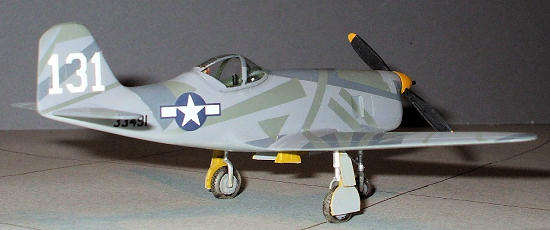
It soon became
apparent to the Bell design team that the XP-77 as originally planned would be
seriously overweight, which if left uncorrected would result in an aircraft
which offered no appreciable advantage in performance over aircraft already in
production. Consequently, the
The two XP-77s were finally delivered in the spring of 1944. Serial numbers were 43-34915 and 43-34916. The low-mounted cantilever wing had a single-spar structure with stressed skin. The wing and the fuselage were largely constructed of resin-bonded laminated wood. The tricycle landing gear was electrically-operated.
When the first of
two XP-77s flew on
Flight
trials continued with the first XP-77, but the USAAF was disappointed by the
aircraft's relatively poor performance. The performance of the XP-77 was
actually inferior to that of aircraft already in service. In addition, by that
time in the war, any danger of an aluminum shortage had passed. Consequently,
the ultralight fighter project was officially abandoned on
| THE KIT |
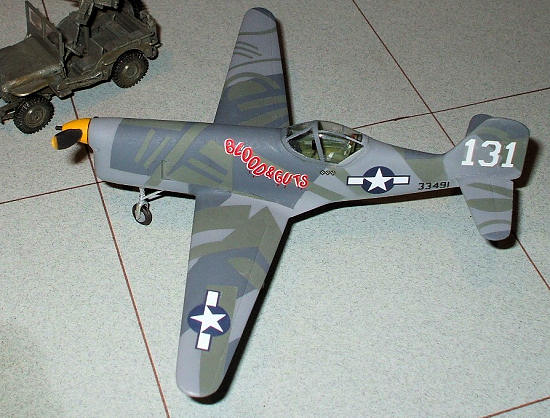 My first
impression upon opening this kit was “Wow, this thing is tiny!”
Well, actually, that’s not true.
My first was “God, I hate these end-opening boxes!!”
How much would a normal box add to the cost, really?
Okay, anyway, it comes outta the box in typical
Czech Model fashion: soft-ish grey plastic with fairly heavy attachment points.
Detail is engraved and on the soft side.
Also included are two vacuformed canopies and some
very nice resin pieces.
The resin bits replace a good number of the kits
plastic pieces, making a simple kit (in parts count anyway) even simpler……or
more difficult, depending on how you view resin parts.
One very clever resin bit is the front wheel well.
It takes up the space of the whole aircraft nose and
includes an engine front. This doubles as a nose weight so hopefully it will not
be a tail dragger.
One piece of resin, a cockpit sidewall, had a pretty
good chunk broken off.
The broken bit was in the bag also, so no real
problem, it can be repaired.
Probably just an unfortunate result of shoving a bag
of delicate resin bits into that dang end-opening box!
(Have I mentioned I don’t like those?) The decal
sheet looks decent.
Not much more can be said about
them though, as they consist of insignia, serial numbers (for two aircraft, oh
boy!!) and a
My first
impression upon opening this kit was “Wow, this thing is tiny!”
Well, actually, that’s not true.
My first was “God, I hate these end-opening boxes!!”
How much would a normal box add to the cost, really?
Okay, anyway, it comes outta the box in typical
Czech Model fashion: soft-ish grey plastic with fairly heavy attachment points.
Detail is engraved and on the soft side.
Also included are two vacuformed canopies and some
very nice resin pieces.
The resin bits replace a good number of the kits
plastic pieces, making a simple kit (in parts count anyway) even simpler……or
more difficult, depending on how you view resin parts.
One very clever resin bit is the front wheel well.
It takes up the space of the whole aircraft nose and
includes an engine front. This doubles as a nose weight so hopefully it will not
be a tail dragger.
One piece of resin, a cockpit sidewall, had a pretty
good chunk broken off.
The broken bit was in the bag also, so no real
problem, it can be repaired.
Probably just an unfortunate result of shoving a bag
of delicate resin bits into that dang end-opening box!
(Have I mentioned I don’t like those?) The decal
sheet looks decent.
Not much more can be said about
them though, as they consist of insignia, serial numbers (for two aircraft, oh
boy!!) and a
| CONSTRUCTION |
Yes, we start with the cockpit. Surprise, surprise! The cockpit tub comprises of 5 resin parts…a floor, two sidewalls, and a front and rear bulkhead. It was a bit of a struggle for me to get this assembled; a very fiddly structure. I also reattached the broken sidewall bit here. When this was dry I added the stick and rudder pedals and then slathered the whole thing with a weak mix of a dark interior green. I then turned my attention to the instrument panel and seat. The seat I painted the same green and then painted the belts and buckles white and silver respectively. A little dab of brown for the leather headrest and I glued this in the cockpit. The instrument panel I painted white, let dry, then painted it black avoiding the instruments. This leaves a bunch of white “sockets” in the panel, admittedly not the best representation, but from a distance it at least gives the look that there is something there. This panel could really benefit from some 1/48 instrument decals, or even a spare panel decal from the stash. I didn’t have either, so I moved on.
Next step is to attach the cockpit to
the fuselage, add the wheel-well/engine/nose-weight piece and button the
fuselage up.
The cockpit fit is dicey…don’t expect Tamiya-like precision
fit here…well, anywhere actually.
I got the tub in straight and level and then added
the nose-weight piece.
It fits quite well.
My only gripe with this piece is that the engine
front shows what looks like a
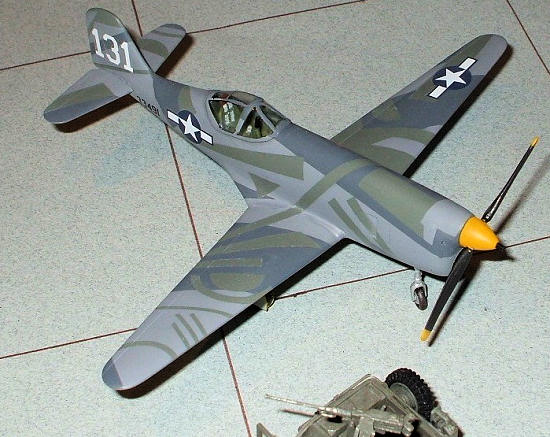 propeller
reduction gear casing straight off a Merlin or Allison.
That would be fine except for
this was a Ranger air-cooled inverted-vee
engine.
There should be nothing really down at the bottom
except the space between the cylinders.
The reduction gear was a small unit pretty much in
line with the crankshaft….i.e., at the top of the engine.
This is nit-picking, I know, it just bugs me.
It is however, much better than nothing and is quite
clever engineering.
Okay, off on a tangent there.
The fuselage halves mated up quite well, but the
front cowl did not.
It seemed a bit too big, but nothing a few minutes
with a sanding stick couldn’t cure.
At this point I drilled out the holes for the two
.50cal machine guns.
Looks much nicer.
propeller
reduction gear casing straight off a Merlin or Allison.
That would be fine except for
this was a Ranger air-cooled inverted-vee
engine.
There should be nothing really down at the bottom
except the space between the cylinders.
The reduction gear was a small unit pretty much in
line with the crankshaft….i.e., at the top of the engine.
This is nit-picking, I know, it just bugs me.
It is however, much better than nothing and is quite
clever engineering.
Okay, off on a tangent there.
The fuselage halves mated up quite well, but the
front cowl did not.
It seemed a bit too big, but nothing a few minutes
with a sanding stick couldn’t cure.
At this point I drilled out the holes for the two
.50cal machine guns.
Looks much nicer.
| COLORS & MARKINGS |
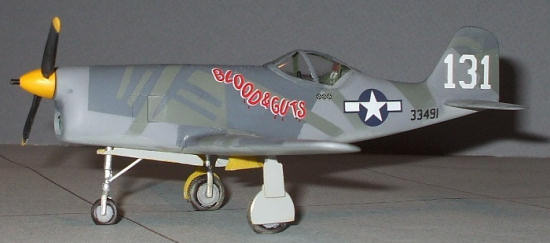
An accomplished painter, illustrator,
sculptor and jewelry designer, McClelland Barclay had developed a very
successful art career by the time he became a Lieutenant in the Naval Reserve in
1938. Barclay's first connection with the Navy came during World War I when he
was awarded the Navy Poster Prize by the Committee on National Preparedness,
1917, for his poster "Fill the Breach." The following year, he worked on Naval
camouflage under William Andrew Mackay, Chief of the New York District Emergency
Fleet Corporation. He renewed his naval connection on
The Barclay camouflage was an art deco extravaganza,
full of spectacular angles, waves, curves, and swirls. Most of the designs were
trapezoidal in nature, and placed at oblique angles relative to the airplane
surfaces. This was intended to break up the outline of the aircraft, and confuse
the perspective from which it was being observed. The colors recommended by Mr.
Barclay were non-specular (flat) Gray, Silver Gray, Blue, and Green. Evaluation
tests, however, showed that pattern camouflage was of
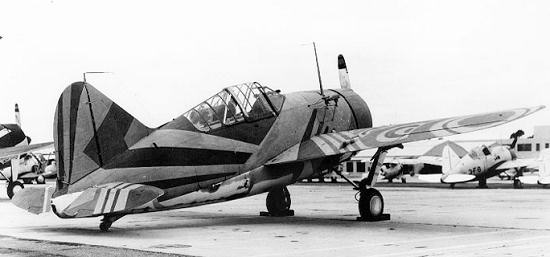 little, if
any, use for the aircraft.
The tests found that while one color would blend in
to the terrain of the area, it made the other colors of the concept stand out
even more. Although a failure in concept, it did provide one very important
idea. Non-specular or flat finishes were desirable to the glossy finishes of the
pre-war era aircraft.
Barclay worked on further
camouflage assignments until 1942, when he was reported missing after the LST he
was aboard was torpedoed in the
little, if
any, use for the aircraft.
The tests found that while one color would blend in
to the terrain of the area, it made the other colors of the concept stand out
even more. Although a failure in concept, it did provide one very important
idea. Non-specular or flat finishes were desirable to the glossy finishes of the
pre-war era aircraft.
Barclay worked on further
camouflage assignments until 1942, when he was reported missing after the LST he
was aboard was torpedoed in the
A failure in concept maybe……or maybe not. When I started thinking about the Barclay camouflage, I thought it might be perfect for, say, a point defense city defender. One that would be flying and fighting over urban, industrial areas. All those rakish angles just might help it blend in with its concrete and steel background. Okay, maybe it wouldn’t…….but it’s a good story and it’ll be fun to try painting something like that.
Now when I thought about what this
mystical city defender would look like, one airplane in particular leapt to my
mind.
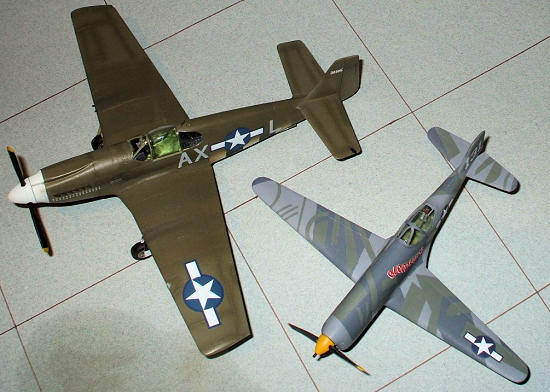 British,
and German colors.
Yes, this should be interesting.
British,
and German colors.
Yes, this should be interesting.
| FINAL BITS |

| CONCLUSIONS |
I am happy with the result of this diminutive fighter. It sizes up nicely in the display case, and Spitfires and Mustangs look like trucks next to it. The kit itself is not difficult; it takes a little putty and sandpaper, but really, what kit doesn’t? T’would be a good starter for anybody wanting to try short run kits. And have fun with it.
| REFERENCES |
If you would like your product reviewed fairly and quickly, please contact me or see other details in the Note to Contributors.